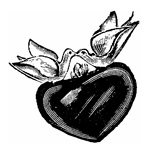
The Universal Heart
WHERE THERE IS A CREATION, THERE IS A CREATOR
“Only fools say in their hearts, ‘There is no God.’” — Psalm 14:1
A paper published in the Oxford Academic Journal of Mammalogy (Feb. 2018) states that 6,399 extant species of mammals inhabit Earth, with a total population numbering about 130 billion. Mammals comprise a group of vertebrate animals that possess backbones and skeletal systems. Individual bones that build a backbone are called vertebrae. Among the thousands of vertebrate animals counted — cats, dogs, rats, deer, monkeys, apes, bats, whales, dolphins, and humans — all are classified as mammals. The world population of non-human mammals greatly exceeds the human population that reached eight billion in November 2022.
In addition to backbones, all mammals possess hearts: the essential organ for life, a marvelous pump for a closed system of blood circulation. Scientific studies of the human heart are vast and ongoing. These have led to medical and surgical treatments that have dramatically enhanced the practice of cardiology. Countless lives have been saved or extended due to these outstanding advances.
The mammalian heart consists of four chambers: the upper left and right atrium (or auricle) and the lower left and right ventricle. Remarkably, all valves and chambers in all mammalian hearts are the same. Also the major artery, the aorta that exits the left ventricle, arches toward the left side of the body in all mammals. Mammalian hearts do not require nervous or electrical stimulation by the brain or central nervous system. Basically, hearts are self-starting and self-sustaining.
In all mammals, the heart is the embryo’s first functioning organ. In humans, its beating begins as early as 16 days after fertilization, according to a team funded by the British Heart Foundation at Oxford University. Approximately 22-23 days after fertilization, the heartbeat can be readily detected. This team also found that a protein called NCX1 facilitates the generation of calcium signals necessary to initiate a heart’s beating. It continues to beat due to special cells that generate electrical activity on their own. Electrical impulses induced in the heart’s natural pacemaker spread over the heart, causing it to contract, thus producing the normal embryonic rate of 100-120 beats per minute.
You May Also Enjoy
The phrase “evolution is a fact, not a theory” seems to emerge from the same realm of the human psyche that gives us “my country right or wrong.”
Since materialism denies the reality of an Intelligent Designer of nature, there is no extrinsic source for a moral code either.
Thomism is an integral part of the millennial flow of Western thought and cannot simply be consigned to the dustbin of misguided and superseded systems of philosophy.

